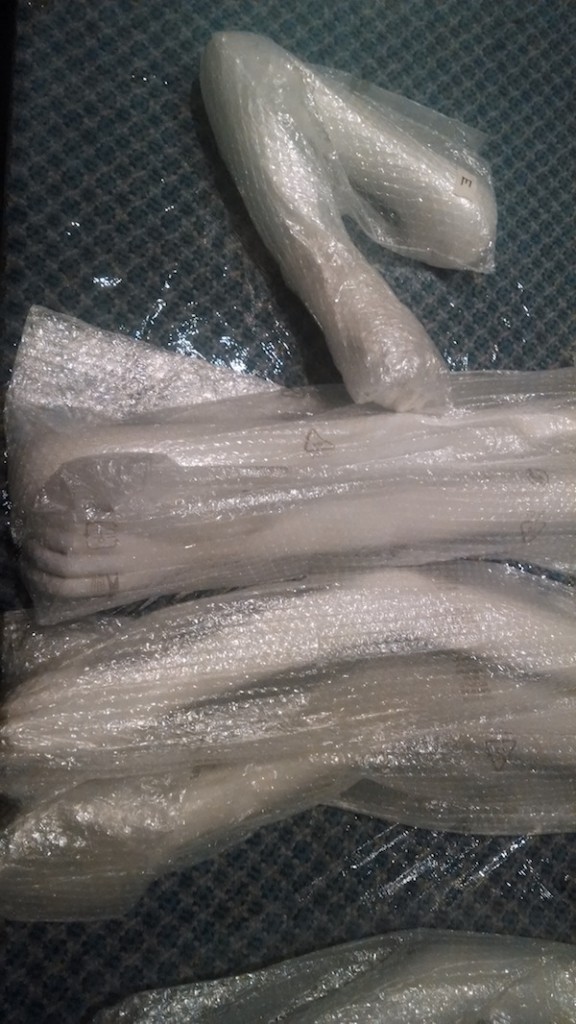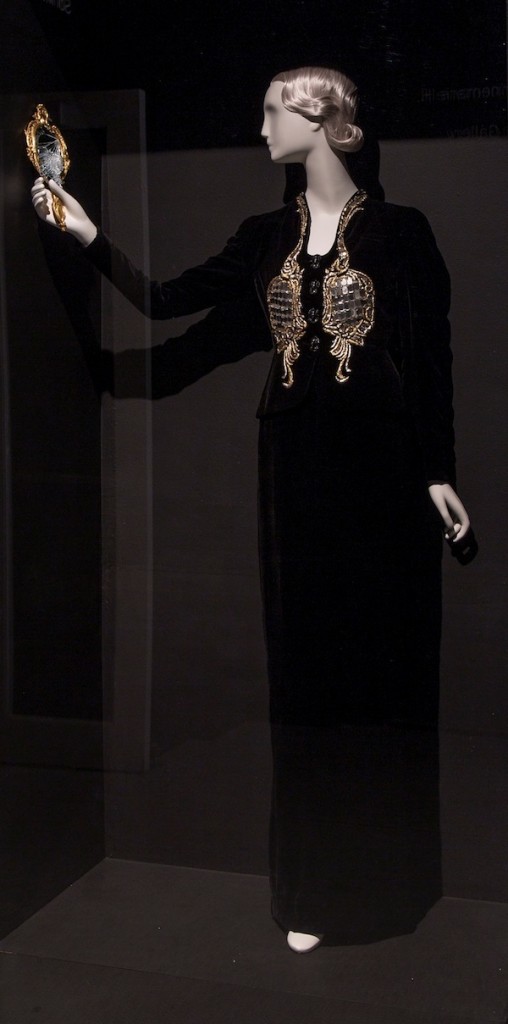
Butterflies, bones, art and fashion at the Bass Museum of Art
By Liz Shannon, Bass Museum of Art
It’s a bit discombobulating to walk into the Taplin gallery and see a pile of bubble-wrapped arms, but that’s par for the course when your upcoming exhibition involves fashion mannequins.
Arms awaiting attachment to their mannequin. Photo: Liz Shannon
To explain, the Bass Museum of Art’s new show is Vanitas: Fashion and Art, which includes avant garde ready-to-wear and haute couture fashion presented alongside contemporary artworks. The exhibition has been conceived and guest curated by the incomparable Harold Koda, Curator in Charge of the Costume Institute at the Metropolitan Museum of Art in New York City. As anyone who has seen one of Mr Koda’s presentations at the Met will know, his exhibitions are thought-provoking, intelligent and spectacular. The shows curated by Mr Koda (who is the extremely dapper gentleman that you might glimpse in photographs alongside Anna Wintour or Muicca Prada) are a veritable ‘Who’s Who’ of contemporary and historical fashion. This probably explains why even the spiffiest staff paid close attention to their shirt-to-jacket-cuff ratio and ensured that their shoes were polished to a particularly high shine during the installation of Vanitas.
Inspired by ‘vanitas’ paintings, a type of still life popular in the Netherlands during the seventeenth century, the exhibition explores the use of vanitas iconography in contemporary fashion and art. Closely linked to depictions of memento mori (reminders of mortality), vanitas artworks often feature more allusive iconography which points to the inevitability of the passing of time, for instance through the representation of clocks and hourglasses; the process of aging and degeneration via flowers and ripe fruit; and things that have a notoriously brief lifespan, such as insects and bubbles. If vanitas still lifes sound less than riveting, it is worth viewing some examples, such as this beautiful seventeenth-century work by Harmen Steenwyck held at the National Gallery in London.
Although technological advances have enabled artists and fashion designers to create works using moving images and 3D printing, as well as the more traditional paint and fabric, the concept of vanitas has remained relevant. The range of artists included in this exhibition – Greta Alfaro, Mat Collishaw, Ori Gersht, Damien Hirst, Jason Salavon, and Sam Taylor-Johnson, to name but a few – underlines the sustained contemporary interest in vanitas themes. However, the fashion industry’s preoccupation with aspirational imagery means that anything suggestive of death and decay tends to be studiously avoided. Nevertheless, vanitas themes periodically emerge: indeed, the sustained use of such imagery by certain designers, such as the much-mourned Alexander McQueen (who, like Damien Hirst, is well-known for using skull motifs), adds a dark, troubling allure to their work. Along with a Monarch Butterfly Dress and Shoes designed by Sarah Burton for Alexander McQueen, the exhibition includes a Spine Corset created by Shaun Leane for McQueen’s 1998 Spring/Summer collection, which features a vestigial tail.

Damien Hirst, St. Peter’s, 2007, silkscreen with glazes on paper, 53 1/8 x 53 1/8 inches, private collection; Alexander McQueen, Monarch Butterfly Dress, Spring/Summer 2011, silk and feathers, courtesy of Alexander McQueen. Installation view at the Bass Museum of Art. Photo by Silvia Ros. Courtesy of the Bass Museum of Art.

Image 3: Shaun Leane for Alexander McQueen, Spine Corset, Spring/Summer 1998, aluminum and leather, courtesy of Shaun Leane Studio; Pinar Yolacan, Untitled (from the Perishables series), C-prints, 2001, 2003 and 2004, 40 x 26 5/8 inches and 40 x 32 3/8 inches, courtesy of the artist. Installation view at the Bass Museum of Art. Photo by Silvia Ros. Courtesy of the Bass Museum of Art.
also features an
and
designed by Karl Lagerfeld for Chanel, both of which appear to have been eaten by moths – surely a waking nightmare for anyone working at the Costume Institute.

Karl Lagerfeld for Chanel, Ensemble and Dress, Spring/Summer 2011, cotton, synthetic tulle and metal, courtesy of the Metropolitan Museum of Art, gift of CHANEL, 2013 (2013.157.1a-b and 2a-b). Installation view at the Bass Museum of Art. Photo by Silvia Ros. Courtesy of the Bass Museum of Art.
An evening jacket by Elsa Schiaparelli, a friend of the Surrealists who created a number of iconic ensembles with Salvador Dalí, is also included, demonstrating that vanitas themes have also been a feature of historical fashion.

Elsa Schiaparelli, Evening Jacket, Winter 1938-39, silk velvet, crepe, metallic thread, beads, glass mirror and plastic, courtesy of the Metropolitan Museum of Art. Gift of Mrs. Pauline Potter, 1950 (C.I.50.34.2). Installation view at the Bass Museum of Art. Photo by Silvia Ros. Courtesy of the Bass Museum of Art.
Vanitas is the first of two exhibitions that will be launched at the Bass over the next month. Given that few exhibitions here involve the assembly of mannequins and the wrangling of spine corsets, this presentation promises to be the first of several very special shows for the museum’s 50th anniversary year.
Recent Content
-
Artsarticle ·
-
Artsarticle ·
-
Artsarticle ·
